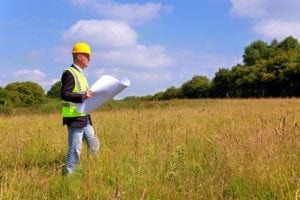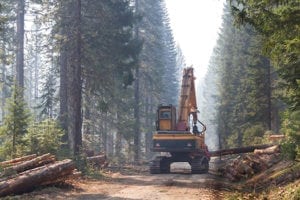
The location of your Katahdin Cedar Log Home is a key element to achieving your dreams. Land acquisition is an important first step in building your new log home. If you’ve purchased land already, don’t stop here, there are still some steps and due diligence you’ll want to take before designing and constructing your new Katahdin home. If you haven’t found your land or lot, some of the tips below can save you time, energy and money, while helping to ensure your home reaches its potential.
Get the Advice of Land Professionals
Purchasing undeveloped land for a residence is a specialized part of real estate. Most brokers spend their time learning and understanding how existing homes are marketed and sold. Few have the specialized knowledge and experience for providing good advice on land. If you’re unable to identify a trusted land realtor, it’s a good idea to hire a professional civil engineer or surveyor to assess the property and develop a site plan. We spoke with Brian Stewart, a Maine-based civil engineer, about some of the steps smart buyers should follow when acquiring land to construct a home.
Is it Buildable?
A civil engineer or land surveyor can help you develop a site plan that will provide guidance for your contractor to utilize the site to its best advantage. “It’s so important not to assume that a building lot will meet your needs,” Stewart said. “Even if the site has been ‘approved’ for building, you need to know if the building envelope is the right place to build on the lot.”
Conditional Purchase
The best way to perform this due diligence is to include specific conditions in the purchase and sale agreement to protect  your purchase. Reasonable conditions might include a boundary survey, development of a site plan, environmental review, and soils testing. Each of these elements will allow the buyer to understand the buildability of the land and whether it meets their specific needs. For example, if a walkout basement is an essential part of your log home design, then ensuring that your building envelope has enough slope to accommodate one would be an important question answered by a topographical survey.
your purchase. Reasonable conditions might include a boundary survey, development of a site plan, environmental review, and soils testing. Each of these elements will allow the buyer to understand the buildability of the land and whether it meets their specific needs. For example, if a walkout basement is an essential part of your log home design, then ensuring that your building envelope has enough slope to accommodate one would be an important question answered by a topographical survey.
Additional Soils Tests Save Money
Often when a parcel is soils-tested for a private septic system, only one or two test pits are dug using an estimated location for the home. Once the house is on site, the test pit location may end up being uphill, or too distant, to be economical to develop. “It doesn’t cost a lot to dig a few more holes to determine the optimal location for the septic in relation to the optimal location for the home,” Stewart noted.
Get Your Contractor on the Same Page
With an engineering site plan in hand, walk the land with your building contractor. He or she should be able to translate the site plan into a reasonable approach for constructing your home on the site. If you’re reviewing several bids, be careful of the “bargain” builder, as there may be costly corners being cut resulting in expensive mistakes. “Water runs downhill and there’s no way around that,” Stewart said. “If your contractor isn’t interested in following the site plan recommendations, there may be problems down the road.”
Just Add Waterfront
If you’re considering a parcel of land that includes a water feature —lake, pond, river or ocean— there’s an added layer of  due diligence to ensure your vision can be constructed. Most states have environmental restrictions when a body of water is part of the property. These may include: building distance from the body of water, existence and planning for wetlands, mean tide levels and flood maps. Some areas may have conservation overlays with specific requirements for building within their boundaries. Building near the water has many benefits, but also adds to some of the challenges for completing your log home.
due diligence to ensure your vision can be constructed. Most states have environmental restrictions when a body of water is part of the property. These may include: building distance from the body of water, existence and planning for wetlands, mean tide levels and flood maps. Some areas may have conservation overlays with specific requirements for building within their boundaries. Building near the water has many benefits, but also adds to some of the challenges for completing your log home.
Budgeting for Site Work
Another piece of the land acquisition puzzle is the site work required for the land. Many home building projects in rural, undeveloped areas include a substantial amount of site work. Just the distance from the main road can add a considerable amount to the total budget. Many homes account for 30% – 40% of the budget just for the site work. Understanding what extra costs might be tied to a particular piece of land is an important piece of knowledge to have. Some of the factors for site work might include:
- cost for adding site utilities
- underground versus overhead utilities
- possible blasting work if there is subsoil rocky ledge
- access road and drainage requirements
- rainwater management
Opting Out of “Perfect”
Understanding the parcel of land and the cost that building might entail is information that is better to know before closing on a particular piece of property. If there appears to be a rush to sell without the exercise of due diligence, it may be better to look elsewhere for the perfect site to build your Katahdin Cedar Log Home.
